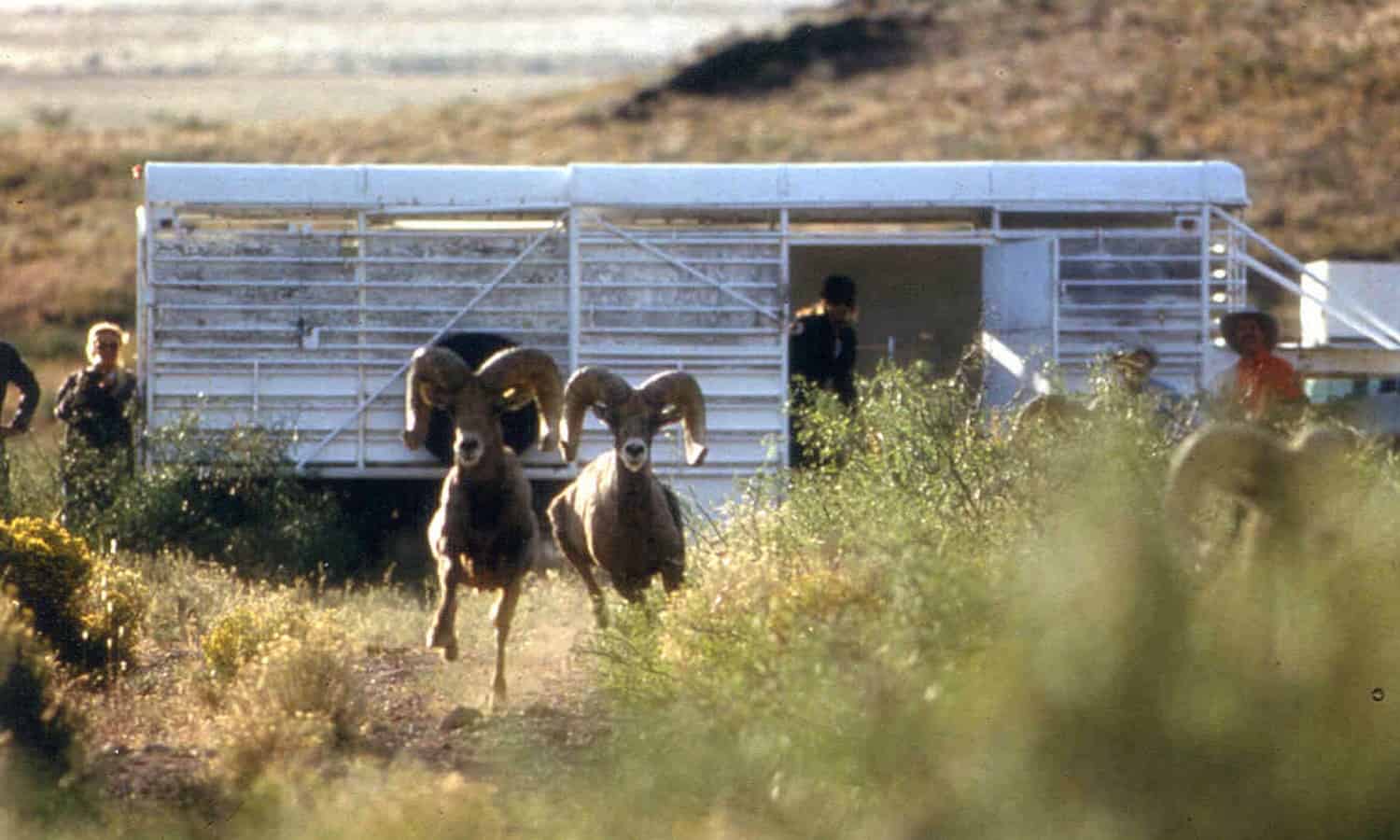Conservation Status
- Listed as endangered in New Mexico in 1980 but, with concerted management by NMDGF (including captive breeding, translocation, and mountain lion control), sheep populations recovered sufficiently to down-list the species in 2009 and delist in 2011
Project Goals & Objectives
The project intends to contribute to desert bighorn sheep recovery by establishing a viable, self-sustaining herd of desert bighorn sheep in the Fra Cristobal Mountains that contributes to improving the conservation status of the species in NM
Objectives
We will work cooperatively with the NMDGF to maintain a desert bighorn sheep population in the Fra Cristobal Mountains that exceeds 300 desert bighorn sheep and includes at least 120 adult ewes. Ideally, 15-20 adult ewes will be translocated from the Fra Cristobal population every 2-4 years to restore, improve, or maintain other populations of sheep in New Mexico. The Fra Cristobal population will support hunter harvest of 6-8 mature rams annually. All mountain lions observed in the Fra Cristobal Mountains will be captured, collared with a GPS transmitter, and tracked to identify habitat use and prey selection. We will work toward cessation of targeted mountain lion management in the Fra Cristobal Mountains by 2025.
Project Background
It is unknown whether the Fra Cristobal Mountain Range on the Armendaris Ranch ever supported native sheep; however, habitat was deemed suitable to support sheep. In a collaborative restoration effort, TESF and NMDGF introduced 37 sheep from the NMDGF captive Red Rock population into the Fra Cristobal Mountains in 1995. An additional seven rams were added to the population in 1997. From 1995 to 2014, 50 mountain lions were captured and removed in the Fra Cristobal mountains. This intensive mountain lion control helped the sheep population to grow to a minimum count of 154 individuals in 2010, and 272 by 2017, including 138 ewes, constituting the largest sheep population in the state.
Growth of, and emigration by, the Fra Cristobal population resulted in a new sheep population in the neighboring Caballo Mountains by 2006, which now comprises over 100 individuals. With successful establishment of the Fra Cristobal sheep population, collaborative efforts have shifted from recovery (e.g., introductions, intensive monitoring, and intensive predator control) to management and sport harvest of the population. Since delisting in 2011, 52 mature rams have been harvested on the Fra Cristobal Mountains through a public-private partnership with NMDGF. Perhaps more importantly, 79 sheep have been transplanted from the Fra Cristobal’s to support sheep restoration and recovery elsewhere in New Mexico.
In 2014, predator control transitioned from the lethal removal of all known mountain lions within the Fra Cristobal mountains to a less invasive strategy of removing only those lions that are documented to kill multiple sheep. Once a mountain lion is documented to have killed three ewes or five total sheep it is subject to removal. Since that time, only 5 of 18 collared lions using the mountains have been removed due to predation on sheep. Substantial information on lion prey selection and diet has been gathered since 2014. Research is currently underway to determine if non-lethal methods can be used to reduce or prevent lion predation on sheep.
Project Activities in 2018
TBD assisted NMDGF with two sheep surveys in 2018 – one ground survey in September when a minimum of 78 sheep were counted and one aerial survey in October when a minimum of 179 sheep were observed. In late 2017, and continuing into 2018, we documented suspicious mortalities of 4 collared sheep (3 ewes/1 ram). These sheep were part of a group of 30 ewes and rams that were collared in 2016 for a graduate project assessing sheep survey techniques. We were able to collect and conduct histopathological analyses of blood and tissue samples to test for pathogens from the ram mortality, as well as from five other desert bighorn rams and two gemsbok (Oryx gazella) harvested by hunters in the Fra Cristobal mountains in 2018. The ram mortality tested positive for Mycoplasma ovipneumoniae, which is a bacterium that can cause pneumonia. Four out of the five hunter harvested rams also tested positive for mycoplasma and one gemsbok tested positive for exposure to epizootic hemorrhagic disease (EHD), but all hunter killed animals otherwise appeared healthy when harvested. An estimated 15% of the Fra Cristobal bighorn population perished due to disease exposure in 2018, hence the lower population counts. We are currently working with NMDGF to monitor and investigate any suspected disease-caused morbidity or mortality of wildlife within the Fra habitat area. Five bighorn rams were harvested by licensed hunters during the 2018-19 season.
We detected three new lions using the Fra Cristobal mountains in 2018. We captured and collared two new lions; one male (ARM11) and one female (ARF06). We recaptured one male lion (ARM07) to exchange collars. One male lion (ARM11) was removed for killing multiple sheep.
From 2014 through 2018, more than 72,000 GPS point locations have been collected from collared mountain lions. The spatial data (e.g., movement and habitat use) represented by these GPS locations is currently being analyzed as part of Hunter Prude’s graduate degree work. Since 2014, TBD staff have investigated approximately 1,135 GPS point clusters, or potential lion kill or feeding sites. Of these, 729 were confirmed to be kill sites. Mountain lion diet composition is diverse, with 31 different prey species being consumed, ranging from carp to gemsbok. Approximately 45% of the combined confirmed lion diet is comprised of small prey items (less than 15 kg), however mule deer are the most selected prey species at 30%. Desert bighorn sheep comprise approximately 4% of the diet (32 documented kills).

